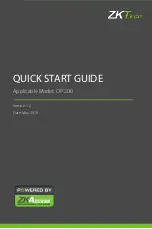
Rev 20.11.2019
V1.07 - Page 8
Subject to modifications!
romutec Steuer.-und Regelsysteme GmbH Jochsberger Straße 39 D-91592 Buch am Wald
www.romutec.de
Subject to technical changes
4.3 Configuration registers
Selection: Inverting of the digital inputs
The logical status of the digital inputs can be inverted by using the register 'Inverting Digital Inputs'.
Selection: ‚Safe State’ of the digital and analog outputs
All digital and analog outputs can be configured so that they will assume a defined state (
‘safe state’) if the
module has not received valid bus telegrams via the MODBus for a certain time. These predefined states
are set separately for each output, whereas the time until activating the safe state is common for all outputs
of a module.
Note: The time for triggering the 'safe state' should not be too short in order to avoid malfunctions
as they can occur, e.g., when another device which is connected to the bus fails and will so cause
time-outs.
Selection of the sensor types for analog inputs
The analog inputs can work with different types of sensors (active and passive ones). The sensor type is
defined for each analog input using a configuration register ('Types of sensors connected to the analog
inputs'). This has an effect on the displayed analog values, as the sensor characteristics are implemented
in the module.
Selection: Automatic baud rate detection or manually setting the baud rate
It can be selected whether the automatic baud rate detection shall be active permanently or only in the first
5 minutes after a cold start. Furthermore, autobauding can also be completely deactivated. In this case, the
device will work with a fixed baud rate which has to be set in another register.
Note: For optimal bus communication it is recommended to set the baud rate to a fixed value and to
disable the automatic baud rate detection while configuring and commissioning the modules.
Setting the value for 'bus timeout'
The safe state function of the outputs will be activated if no valid bus telegram is received for a certain time.
This time is defined by t
he value which is set in the register ‘bus timeout’.
Register used for sending a command to the module
By means of this register, functions like the reset of all configuration registers can be triggered by sending a
command to the device.









































